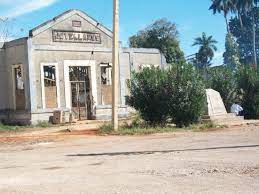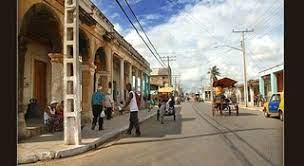JOVELLANOS, UNA CIUDAD CUBANA QUE VIVE DE RECUERDOS Y PASADAS GLORIAS
El municipio se divide en los barrios de Asunción, Isabel, Realengo y San José.
La antigua industria que hizo famosa al pueblo por su excelente pasta de dientes, la recordada Pasta Gravi, ahora pertenece a la empresa mixta Suchel, es facturada con productos de poca personalidad y peor sabor.
Los días de gloria perdidos de su fábrica insignia es sólo uno de los muchos problemas de este pueblo de la provincia de Matanza, atravesado por la carretera y la línea principal del ferrocarril. Si hace seis décadas la zona tenía una economía en crecimiento, hoy sus habitantes recuerdan glorias pasadas e imaginan lo que pudo haber sido.
El lugar ya no es un destino de trabajadores y se ha convertido en una fuente de trabajadores para las zonas turísticas de Varadero. “Aquí no hay mucho que hacer, entonces la gente se va y los jóvenes son los primeros en irse”, dice Ramón, nacido en Jovellanos hace 62 años. El jueves estaba almorzando en un restaurante privado del pueblo con unos familiares de Miami. Con el sugerente nombre de Kitsch, decorado con muebles y lámparas barrocas, el restaurante es uno de los pocos que existen en el pequeño pueblo. Los jóvenes se quejan de que no hay discoteca y tienen que conformarse con un deprimente cabaret en las afueras del pueblo, muy frecuentado por moscas y borrachos.
Joachim, de 85 años, dice que no se fue de Jovellanos porque siempre creyó que “las cosas mejorarían. Cuando me di cuenta, ya era demasiado tarde para salir “. Trabajó en uno de los dos ingenios azucareros que, durante la época de la zafra, “no paraba nunca de moler”, dice con entusiasmo. Ahora, “los dos están cerrados e inútiles, pura basura tirada en el campo”, lamenta.
En las calles de la pequeña ciudad, muchas casas tienen carteles que dicen “Se vende”. Por poco más de 12.000 pesos cubanos convertibles (aproximadamente 12.000 dólares estadounidenses), Alina ofrece la casa donde nació y que fue construida por su abuelo. Tiene cinco dormitorios y una gran terraza. “No quiero quedarme aquí, porque tengo que darles un futuro a mis hijos”, dice. Su plan es alquilar por unos meses en la capital y finalmente emigrar a Estados Unidos con el dinero.
Como en cualquier otro lugar de Cuba, en esta ciudad los timbiriches privados, pequeños quioscos de “mamá y papá”, han superado a los bares estatales. Vendedores de bisutería y útiles cacharros ofrecen furtivamente sus mercancías en los portales de la calle principal. “Una vez tuvimos tres ferreterías, cuatro almacenes generales, dos mueblerías y una imprenta, pero eso fue hace mucho tiempo”, recuerda Joaquín.
Todo el transporte de la ciudad hoy se realiza en carros tirados por caballos o bicicletas. “Para salir del pueblo hay camiones privados, pero de noche es difícil coger uno”, dice el conductor de un viejo jeep que recorre la ruta a Matanzas.
La sede local del Partido Comunista está ubicada en un hermoso edificio, que alguna vez albergó la Asociación de Pequeños Colonos del territorio. “Ellos criticaron tanto a los viejos terratenientes y miran cómo han destruido la tierra”, comenta Joaquín, quien recuerda cuando la región “se jactaba” de sus fincas con frutas e importantes cultivos de hortalizas y granos.
HISTORIA
Fue fundado en 1842 como Corral de la Bemba en la ubicación de un antiguo rancho llamado Bemba. Renombrado Jovellanos en 1870, debido a los esfuerzos de un alcalde originario de Asturias. A mediados del siglo pasado contaba con una biblioteca, dos salas de cine, una de las cuales también servía como teatro en vivo. Ahora solo queda uno en funcionamiento, mientras que el otro es solo un edificio con puertas tapiadas y una fachada descolorida.
Jovellanos también es llamado “Bemba” por sus habitantes y lugareños. “Bemba” significa “labio grande” en español cubano; este término se refiere a la población negra de la ciudad. Para los forasteros, puede tener connotaciones raciales negativas, pero en la ciudad este no es el caso. Dentro de Jovellanos, la mayor parte de la población blanca y negra vive en armonía, una al lado de la otra. Por lo tanto, “Bemba” es un nombre cariñoso para el pueblo utilizado por los lugareños.
DEMOGRAFIA
En 2004, el municipio de Jovellanos tenía una población de 58.685 habitantes. Con una superficie total de 505 km2 (195 millas cuadradas), tiene una densidad de población de 116,2 / km2 (301 millas cuadradas).
LOS RECUERDOS DE UN PUEBLO…
En 1959 tenían planeado construir una fábrica de mermeladas en un lote baldío frente al molino de arroz y la planta eléctrica, “pero llegó el Comandante (Fidel Castro) y ordenó que se detuviera”, comenta la gente satíricamente.
Hace poco más de medio siglo se erigió una planta para ensamblar motores con tecnología búlgara, pero ya no funciona. También se instaló una moderna fundición, pero poco tiempo después de su lanzamiento tuvo que ser desmontada.
Un vecino de Jovellano que estuvo involucrado en esa obra y luego emigró a La Habana dijo, “los inversionistas de la fundición no habían tenido en cuenta la electricidad requerida para esta obra y cuando la fundición comenzó a funcionar todo el pueblo se quedó a oscuras”.
Ya no existe la fábrica de refrescos que era el orgullo de la región, ni la fábrica de cuerdas, ni el tostador de café, ni el matadero de carne, ni la fábrica de bloques de cemento, ni las queserías. Todas las conversaciones con residentes mayores de 60 años terminan invariablemente en una revisión de estas glorias pasadas.
Algunas de las personas más jóvenes dicen que recuerdan el sabor de la pasta de dientes Gravi, “la reina de la pasta de dientes”, pero a su edad es poco probable. En Jovellanos, quienes no quieren aceptar la suerte de su gente se refugian en el pasado para escapar del presente.
JOVELLANOS, A CUBAN CITY THAT LIVES ON MEMORIES AND PAST GLORIES
The municipality is divided into the neighborhoods of Asunción, Isabel, Realengo, and San José.
The old industry that made the town famous for its excellent toothpaste, the well-remembered Pasta Gravi, now owned by the Suchel joint venture, is billed with products with little personality and worse taste.
The lost glory days of its flagship factory is just one of the many problems of this town in the Matanza province, crossed by the highway and the main railway line. If six decades ago the area had a growing economy, today its inhabitants remember past glories and imagine what could have been.
The place is no longer a destination for workers and has become a source of workers for the tourist areas of Varadero. “There is not much to do here, so people leave and young people are the first to leave,” says Ramón, born in Jovellanos 62 years ago. On Thursday he was having lunch at a private restaurant in town with some relatives from Miami. With the suggestive name of Kitsch, decorated with baroque furniture and lamps, the restaurant is one of the few that exist in the small town. Young people complain that there is no disco and have to settle for a depressing cabaret on the outskirts of town, frequented by flies and drunks.
Joachim, 85, says that he did not leave Jovellanos because he always believed that “things would get better. When I realized it, it was too late to leave. “He worked in one of the two sugar mills that, during the harvest season,” never stopped grinding, “he says enthusiastically. Now,” both are closed and useless, pure garbage thrown in the field ”, he laments.
On the streets of the small town, many houses have signs that say “For Sale.” For just over 12,000 Cuban convertible pesos (approximately US $ 12,000), Alina offers the house where she was born and which was built by her grandfather. It has five bedrooms and a large terrace. “I don’t want to stay here, because I have to give my children a future,” she says. Her plan is to rent for a few months in the capital and finally emigrate to the United States with the money.
As in any other place in Cuba, in this city, the private timbiriches, small “mom and dad” kiosks, have surpassed the state bars. Sellers of jewelry and useful gadgets sneak their wares on the portals of the main street. “Once we had three hardware stores, four general stores, two furniture stores, and a printing company, but that was a long time ago,” recalls Joaquín.
All city transportation today is done by horse-drawn carts or bicycles. “There are private trucks to get out of town, but at night it is difficult to take one,” says the driver of an old jeep that travels the route to Matanzas.
The local headquarters of the Communist Party is located in a beautiful building, which once housed the Small Settlers Association of the territory. “They criticized the old landowners so much and they look at how they have destroyed the land,” says Joaquín, who remembers when the region “boasted” of its farms with fruits and important crops of vegetables and grains.
HISTORY
It was founded in 1842 as Corral de la Bemba on the location of an old ranch called Bemba. Renamed Jovellanos in 1870, due to the efforts of a mayor originally from Asturias. In the middle of the last century, it had a library, two movie theaters, one of which also served as a live theater. Now only one remains in operation, while the other is just a building with bricked-up doors and a faded facade.
Jovellanos is also called “Bemba” by its inhabitants and locals. “Bemba” means “big lip” in Cuban Spanish; this term refers to the black population of the city. For outsiders, it may have negative racial connotations, but in the city, this is not the case. Within Jovellanos, most of the black and white population live in harmony, one next to the other. Hence, “Bemba” is an affectionate name for the village used by the locals.
DEMOGRAPHY
In 2004, the municipality of Jovellanos had a population of 58,685 inhabitants. With a total area of 505 km2 (195 square miles), it has a population density of 116.2 / km2 (301 square miles).
MEMORIES OF A PEOPLE …
In 1959 they planned to build a jam factory on a vacant lot in front of the rice mill and the power plant, “but the Commander (Fidel Castro) arrived and ordered it to stop,” people say satirically.
A little over half a century ago a plant was built to assemble motors with Bulgarian technology, but it is no longer working. A modern foundry was also installed, but shortly after its launch, it had to be dismantled.
A Jovellano neighbor who was involved in that work and later emigrated to Havana said, “the investors in the foundry had not taken into account the electricity required for this work and when the foundry began to operate, the entire town was left in the dark.” .
There is no longer the soft drink factory that was the pride of the region, nor the rope factory, nor the coffee roaster, nor the meat slaughterhouse, nor the cement block factory, nor the cheese factories. All conversations with residents over 60 invariably end in a review of these past glories.
Some of the younger people say they remember the taste of Gravi toothpaste, “the queen of toothpaste”, but at her age it is unlikely. In Jovellanos, those who do not want to accept the fate of their people take refuge in the past to escape the present.
Agencies/ WIki/ 14ymedio/ Pedro Acosta/ Internet Photos/ Arnoldo Varona/ www.TheCubanHistory.com
THE CUBAN HISTORY, HOLLYWOOD.



 JOVELLANOS, a Cuban City that Lives on Memories and Past Glories. * JOVELLANOS, una Ciudad Cubana que Vive de sus Recuerdos y Pasadas Glorias. PHOTOS.
JOVELLANOS, a Cuban City that Lives on Memories and Past Glories. * JOVELLANOS, una Ciudad Cubana que Vive de sus Recuerdos y Pasadas Glorias. PHOTOS.












